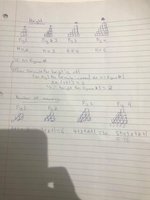Hi, I need help with coming up with an equation for the number of squares in each sequence. I have attached a copy of the question and I found out how to calculate the height in each figure by taking the figure number and then adding 1 which will give the height for any sequence. I am not sure how to calculate the number of squares, I have counted the total number of squares for each figure by counting diagonally from the top of the staircase but I am not sure how to come up with an equation?
You are using an out of date browser. It may not display this or other websites correctly.
You should upgrade or use an alternative browser.
You should upgrade or use an alternative browser.
staircase sequence
- Thread starter Teresa
- Start date
pka
Elite Member
- Joined
- Jan 29, 2005
- Messages
- 11,971
I agree with all of your work.Hi, I need help with coming up with an equation for the number of squares in each sequence. I have attached a copy of the question and I found out how to calculate the height in each figure by taking the figure number and then adding 1 which will give the height for any sequence. I am not sure how to calculate the number of squares, I have counted the total number of squares for each figure by counting diagonally from the top of the staircase but I am not sure how to come up with an equation?
You might note that \(1+2+3+\cdots+n-1+n=\dfrac{n(n+1)}{2}\)
Steven G
Elite Member
- Joined
- Dec 30, 2014
- Messages
- 14,383
Let k = 1+2 +3 +4 +5 +6 +7 +8 + 9 + 10 and then write it backwards
k = 1 + 2 + 3 + 4 + 5 + 6 + 7 + 8 + 9 + 10
k= 10 +9 + 8 + 7 + 6 + 5 + 4 + 3 + 2 + 1
How would you add the right hand side? After adding it what would k equal?
Now we do the same thing with:
S = 1 + 2 + 3 + ... + n
S = n+(n-1)+(n-2) + ... + 1
Now what does S equal?
k = 1 + 2 + 3 + 4 + 5 + 6 + 7 + 8 + 9 + 10
k= 10 +9 + 8 + 7 + 6 + 5 + 4 + 3 + 2 + 1
How would you add the right hand side? After adding it what would k equal?
Now we do the same thing with:
S = 1 + 2 + 3 + ... + n
S = n+(n-1)+(n-2) + ... + 1
Now what does S equal?
Dr.Peterson
Elite Member
- Joined
- Nov 12, 2017
- Messages
- 16,087
Another way to see the same idea is to make a second copy of the figure and put it upside-down on top of the first copy, to make a rectangle. It's easy to find the size of the rectangle ...
Steven G
Elite Member
- Joined
- Dec 30, 2014
- Messages
- 14,383
Yes, that is what Dr Peterson meant. Now how do you use that information to find out the number of squares in fig 1? Remember that whatever you say must also work for the other figures as well.Do you mean to make a second copy of figure # 1 and put that figure on top of the original figure 1, that would then give me a total of 6 squares?


